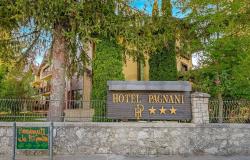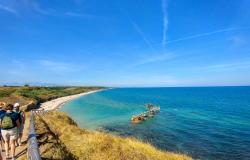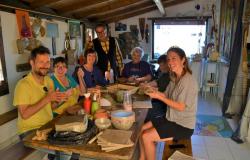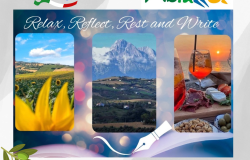In a previous article Nick Calvano told Italy Magazine how he found his Italian relatives through the internet and met them in March 2001. Now he and his wife Margaret tell Pat Eggleton what happened when they went to Vasto in Abruzzo.
After leaving Bergamo, euphoric about having met relatives that we had found through the Internet, Marge and I drove to Vasto [Abruzzo] where my father was born. We were hoping to find some information about him and perhaps my grandfather, Giuseppe. With luck, we thought, we might even find something on my grandmother, Liberata Dilello, who was also born and raised in Vasto.
 We had visited two years earlier but during our brief stay the records office was closed so we could not search for relatives. During that visit we found that very few people in Vasto spoke or understood English. That was less of a problem this time because I had made a real effort to learn Italian. But sometimes you have to be creative.
We had visited two years earlier but during our brief stay the records office was closed so we could not search for relatives. During that visit we found that very few people in Vasto spoke or understood English. That was less of a problem this time because I had made a real effort to learn Italian. But sometimes you have to be creative.
First we went to the city's cemetery thinking that they might have records, since many U.S. cemeteries do. They didn’t. When I asked someone for directions to the cemetery, he didn’t understand me. Interestingly, the Italian word is practically the same as English (cimitero). Had I simply used the Italian pronunciation of cemetery he probably would have understood but I didn’t know that and after getting a blank stare I asked, “Dove sono i morti?” (Where are the dead?) He understood and directed us with a smile on his face.
Unfortunately, the only help we got from the cemetery attendant was an escorted tour of some of the Calvanos buried there. I had no way of knowing if any of them were relatives. We were disappointed and afraid we might not have any better luck in the archives but, undaunted, we headed for that office.
The records office was open and I marched right up to the first window to ask for information on my father, Domenico Calvano. With my limited but improved Italian vocabulary I was able to make the clerk understand that I wanted to see the records of my father's birth. While I was saying my father’s name I noticed another man in the office poking his head out from behind a pillar.
He had a look of astonishment on his face; then, as the clerk was getting more information from me, the astonished face appeared at his side and spoke so fast that I only caught about every fifth word. In short, I had no idea what he was saying. Finally, he pulled out his driver's licence and showed me that his name was Fernando Calvano and made me understand that apparently he was familiar with the name, Domenico Calvano.
 Although Calvano is not a common name in Vasto, neither is it rare so there were probably many Calvanos who were not related to me and I thought Fernando might have been one of them. He babbled on for some time, alternating between speaking to me and giving orders to the clerk.
Although Calvano is not a common name in Vasto, neither is it rare so there were probably many Calvanos who were not related to me and I thought Fernando might have been one of them. He babbled on for some time, alternating between speaking to me and giving orders to the clerk.
Then he motioned that he wanted us to follow him and led us to a back room where her reached up on a shelf and pulled down an old leather-bound book. He turned the fragile pages until he came to the place where the names of my grandparents were recorded.
There they were: Giuseppe Calvano, Liberata Dilello; then the names of their four children: Angelo, who died when he was 6 months old, Maria, Nicola, and my father, Domenico. I never knew about Angelo.
I actually had to choke back tears. Here in this book that was more than 100 years old, I was looking at the original entry of my father’s birth in beautiful flowing script. And I learned about an uncle named Angelo who died before reaching his first birthday.
I will never know if my father knew about Angelo because he died seven years before we made this trip. I would not have expected this to be an emotional experience, but it was.
Also listed was my great grandfather, Carmine. Marge tried to make notes but he stopped her. I thought it was peculiar that we weren’t allowed to take notes but I didn’t question him, mainly because my Italian wasn’t good enough.
I noticed, though, that he was inserting pieces of scrap paper into the book, marking off the significant pages. Then I think he said that he would meet us in the evening at our hotel. Catching only about every fifth word makes it difficult to understand sometimes.
 That evening, after dinner, we returned to our hotel to find Fernando waiting in the lobby. He held a sheet of paper with a rough sketch of our family tree and by running his finger from name to name showed us how he was related to me. I had trouble following at first because there were so many names that I didn’t recognize. Then I saw “Carmine,” my great grandfather, then my grandfather “Giuseppe,” then my father “Domenico.” It was like a fog lifting and it started to make sense. I knew we had struck gold. It gets better.
That evening, after dinner, we returned to our hotel to find Fernando waiting in the lobby. He held a sheet of paper with a rough sketch of our family tree and by running his finger from name to name showed us how he was related to me. I had trouble following at first because there were so many names that I didn’t recognize. Then I saw “Carmine,” my great grandfather, then my grandfather “Giuseppe,” then my father “Domenico.” It was like a fog lifting and it started to make sense. I knew we had struck gold. It gets better.
Fernando had never met Michele, my cousin whom we had met for the first time a few days earlier, but he showed me his name along with his wife, Celestina and his daughters, Stefania and Daniela. He also showed us that Michele’s grandfather and my grandfather were brothers. Everything tied together. This was incredible. I was hoping to get records of my father and maybe my grandfather and was presented with names, births and deaths of all my relatives going back many generations.
Now I understood why he waved Marge off when she tried to take notes at the records office. He was going to do it for us. But he didn’t give me his notes. Instead, he neatly folded the papers, placed them in his pocket and let out a fast string of Italian that went completely past me. Would he ever give us this information?
With some struggling I figured out that he wanted to meet us the next day. So the next afternoon we went back to his office and from there he led us through the twisting streets of old Vasto to his house where he produced a completed, printed genealogical chart of our family.
On it, he showed me the records of my family that went back to 1700 in Saludecio, a small mountain town about 150 miles north of Vasto. Missing, of course, was the information on my immediate family: my mother, Grace; my sister, Norma; and our children, Vincent, Victoria, Jacqueline and Paul.
 We filled that in later. Fernando rolled up the chart and handed it to me. I could not have been happier if he had handed me a brick of gold bullion. Finally, I had all of this valuable information in my hands and couldn’t wait to pass it on to other members of the family at home. Fernando returned to his office and we wandered through old Vasto, stopped at a pastry shop and treated ourselves to some of the best pastries in the world.
We filled that in later. Fernando rolled up the chart and handed it to me. I could not have been happier if he had handed me a brick of gold bullion. Finally, I had all of this valuable information in my hands and couldn’t wait to pass it on to other members of the family at home. Fernando returned to his office and we wandered through old Vasto, stopped at a pastry shop and treated ourselves to some of the best pastries in the world.
On the way back to our hotel, we stopped by his house to take a photo. There was a pretty little girl about seven years old playing in the courtyard. I approached her and said, “Come ti chiami?.” (“What is your name?”) She responded, “Claudia” and I asked, “E il tuo cognome?” (“And your surname?”). “Calvano” she said, smiling. “E tuo padre si chiama Fernando, vero?” (“And your father’s name is Fernando, right?”} “Si.” This was Fernando’s daughter. Walking back to our hotel, I couldn’t stop smiling. I had actually had a real conversation with an Italian who spoke no English and she had understood me!
That evening we met Fernando, his wife, Domenica and his two daughters, Cinzia and Claudia. We had a fantastic six-course seafood dinner with them and the next day we left with that precious chart of our family tree that he had prepared. A perfect trip. Just three days earlier we had met my relatives in Bergamo after finding them through the Internet, and now we had concluded the trip by meeting more relatives that I didn’t know existed, in my father’s home town.. As if that wasn’t enough, my new-found cousin had presented me with a genealogical chart dating back to 1700!
The last time we saw Fernando and his family was in July, 2004 after having attended Stefania’s wedding in Milan. Luckily, we happened to be in Vasto during a festival where residents dressed up in period costumes dating back to the middle ages to celebrate the founding of the city. Two years later, while walking on the beach with his wife, Domenica, Fernando had a heart attack and died. It was their twenty-fifth wedding anniversary. He was only in his mid- fifties.
We continue to stay in touch with his daughters, Cinzia and Claudia, through email and Facebook.
We’ll never forget Fernando.





